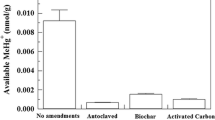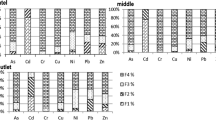Abstract
The effect of dredged sediment reuse on the production and bioconcentration of monomethylmercury (MMHg) was investigated by examining sediments and ragworms found in dredge material banks and surrounding sites in the Venice Lagoon, Italy. Total Hg concentrations in the surface 20 cm of sediments were higher in the banks than in the surrounding sites, but MMHg concentrations were similar, which suggests reduced MMHg production in the banks. Monomethylmercury content in ragworms was significantly lower (p < 0.05) in the banks than in the surrounding sites. In pore water, concentrations of both sulfate and Fe decreased with depth in the upper 20 cm of the dredge banks. In contrast, sulfate concentrations were constant with depth and large amounts of dissolved Fe occurred in the upper 20 cm of sediments of surrounding sites. Continuous sulfate reduction and possible precipitation of iron sulfide may decrease the production and bioconcentration of MMHg in the dredge material banks compared to the surrounding sites. Overall, the production of MMHg in sediments and its bioconcentration in benthic organisms were connected to the process of sediment diagenesis of organic matter through the control of pore water and sediment geochemistry involving iron and sulfur.




Similar content being viewed by others
References
Barbanti, A., Bergamini, M. C., Frascari, E., Miserocchi, S., Ratta, M., & Rosso, G. (1995). Diagenetic processes and nutrient fluxes at the sediment–water interface, Northern Adriatic, Italy. Marine and Freshwater Research, 46, 55–67.
Bloom, N. (1989). Determination of pictogram levels of methylmercury by aqueous phase ethylation, followed by cryogenic gas-chromatography with cold vapor atomic fluorescence detection. Canadian Journal of Fisheries and Aquatic Sciences, 46, 1131–1140.
Bloom, N. S., Gill, G. A., Cappellino, S., Dobbs, C., McShea, L., Driscoll, C., et al. (1999). Speciation and cycling of mercury in Lavaca Bay, Texas, sediments. Environmental Science & Technology, 33, 7–13.
Bloom, N. S., Moretto, L. M., Scopece, P., & Ugo, P. (2004). Seasonal cycling of mercury and monomethyl mercury in the Venice Lagoon (Italy). Marine Chemistry, 91, 85–99.
Chen, C. Y., Dionne, M., Mayes, B. M., Ward, D. M., Sturup, S., & Jackson, B. P. (2009). Mercury bioavailability and bioaccumulation in estuarine food webs in the Gulf of Maine. Environmental Science & Technology, 43, 1804–1810.
Choe, K. Y., Gill, G. A., Lehman, R. D., Han, S., Heim, W. A., & Coale, K. H. (2004). Sediment–water exchange of total mercury and monomethyl mercury in the San Francisco Bay-Delta. Limnology and Oceanography, 49, 1512–1527.
Clarisse, O., Ouddane, B., Fischer, J. C., & Wartel, M. (2003). Metals sediment toxicity: Chemical approach by SEM/AVS ratio. Application on Seine estuary sediments. Journal of Physics IV, 107, 303–306.
Coelho, J. P., Nunes, M., Dolbeth, M., Pereira, M. E., Duarte, A. C., & Pardal, M. A. (2008). The role of two sediment-dwelling invertebrates on the mercury transfer from sediments to the estuarine trophic web. Estuarine, Coastal and Shelf Science, 78, 505–512.
Covelli, S., Faganeli, J., Horvat, M., & Brambati, A. (1999). Porewater distribution and benthic flux measurements of mercury and methylmercury in the Gulf of Trieste (Northern Adriatic Sea). Estuarine, Coastal and Shelf Science, 48, 415–428.
Deheyn, D. D., & Shaffer, L. R. (2007). Saving Venice: Engineering and ecology in the Venice Lagoon. Technology in Society, 29, 205–213.
Drott, A., Lambertsson, L., Bjorn, E., & Skyllberg, U. (2007). Importance of dissolved neutral mercury sulfides for methyl mercury production in contaminated sediments. Environmental Science & Technology, 41, 2270–2276.
Durou, C., Poirier, L., Amiard, J. C., Budzinski, H., Gnassia-Barelli, M., Lemenach, K., et al. (2007). Biomonitoring in a clean and a multi-contaminated estuary based on biomarkers and chemical analyses in the endobenthic worm Nereis diversicolor. Environmental Pollution, 148, 445–458.
Fitzgerald, W. F., Lamborg, C. H., & Hammerschmidt, C. R. (2007). Marine biogeochemical cycling of mercury. Chemical Reviews, 107, 641–662.
Gieskes, J. M., Gamo, T., & Brumsack, H. (1991). Chemical methods for interstitial water analysis aboard JOIDES Resolution. Technical Note Vol. 15. College Station: Ocean Drilling Program.
Gill, G. A., & Bruland, K. W. (1990). Mercury speciation in surface freshwater systems in California and other areas. Environmental Science & Technology, 24, 1392–1400.
Gill, G. A., Bloom, N. S., Cappellino, S., Driscoll, C. T., Dobbs, C., McShea, L., et al. (1999). Sediment–water fluxes of mercury in Lavaca Bay, Texas. Environmental Science & Technology, 33(5), 663–669.
Hammerschmidt, C. R., & Fitzgerald, W. F. (2004). Geochemical controls on the production and distribution of methylmercury in near-shore marine sediments. Environmental Science & Technology, 38, 1487–1495.
Hammerschmidt, C. R., Fitzgerald, W. F., Balcom, P. H., & Visscher, P. T. (2008). Organic matter and sulfide inhibit methylmercury production in sediments of New York/New Jersey Harbor. Marine Chemistry, 109, 165–182.
Han, S., Obraztsova, A., Pretto, P., Choe, K. Y., Gieskes, J., Deheyn, D. D., et al. (2007). Biogeochemical factors affecting mercury methylation in sediments of the Venice Lagoon, Italy. Environmental Toxicology and Chemistry, 26, 655–663.
Han, S., Obraztsova, A., Pretto, P., Deheyn, D. D., Gieskes, J., & Tebo, B. M. (2008). Sulfide and iron control on mercury speciation in anoxic estuarine sediment slurries. Marine Chemistry, 111, 214–220.
Hinkey, L. M., & Zaidi, B. R. (2007). Difference in SEM-AVS and ERM-ERL predictions of sediment impacts from metals in two US Virgin Islands marinas. Marine Pollution Bulletin, 54, 180–185.
Hollweg, T. A., Gilmour, C. C., & Mason, R. P. (2009). Methylmercury production in sediments of Chesapeake Bay and the mid-Atlantic continental margin. Marine Chemistry, 114, 86–101.
Jorgensen, B. B., Bottcher, M. E., Luschen, H., Neretin, L. N., & Volkov, I. I. (2004). Anaerobic methane oxidation and a deep H2S sink generate isotopically heavy sulfides in Black Sea sediments. Geochimica et Cosmochimica Acta, 68, 2095–2118.
King, J. K., Kostka, J. E., Frischer, M. E., Saunders, F. M., & Jahnke, R. A. (2001). A quantitative relationship that remonstrates mercury methylation rates in marine sediments are based on the community composition and activity of sulfate-reducing bacteria. Environmental Science & Technology, 35, 2491–2496.
Lawrence, A. L., & Mason, R. P. (2001). Factors controlling the bioaccumulation of mercury and methylmercury by the estuarine amphipod Leptocheirus plumulosus. Environmental Pollution, 111, 217–231.
Liang, L., Horvat, M., & Bloom, N. S. (1994). An improved speciation method for mercury by GC/CVAFS after aqueous phase ethylation and room temperature precollection. Talanta, 41, 371–379.
Liu, J. R., Valsaraj, K. T., & Delaune, R. D. (2009). Inhibition of mercury methylation by iron sulfides in an anoxic sediment. Environmental Engineering Science, 26, 833–840.
Mason, R. P., & Lawrence, A. L. (1999). Concentration, distribution, and bioavailability of mercury and methylmercury in sediments of Baltimore Harbor and Chesapeake Bay, Maryland, USA. Environmental Toxicology and Chemistry, 18, 2438–2447.
Meador, J. P., Ernest, D. W., & Kagley, A. N. (2005). A comparison of the non-essential elements cadmium, mercury, and lead found in fish and sediment from Alaska and California. The Science of the Total Environment, 339, 189–205.
Merritt, K. A., & Amirbahman, A. (2007). Mercury dynamics in sulfide-rich sediments: Geochemical influence on contaminant mobilization within the Penobscot River estuary, Maine, USA. Geochimica et Cosmochimica Acta, 71, 929–941.
Muhaya, B. B. M., Leermakers, M., & Baeyens, W. (1997). Total mercury and methylmercury in sediments and in the polychaete Nereis diversicolor at Groot Buitenschoor (Scheldt estuary, Belgium). Water, Air, and Soil Pollution, 94, 109–123.
Muresan, B., Cossa, D., Jezequel, D., Prevot, F., & Kerbellec, S. (2007). The biogeochemistry of mercury at the sediment–water interface in the Thau lagoon. 1. Partition and speciation. Estuarine, Coastal and Shelf Science, 72, 472–484.
Niesson, S., Foucher, D., Clarisse, O., Fischer, J. C., Mikac, N., Kwokal, Z., et al. (2003). Influence of sulphur cycle on mercury methylation in estuarine sediment (Seine estuary, France). Journal de Physique IV, 107, 953–956.
Nuutinen, S., & Kukkonen, J. V. K. (1998). The effect of selenium and organic material in lake sediments on the bioaccumulation of methylmercury by Lumbriculus variegatus (oligochaeta). Biogeochemistry, 40, 267–278.
Prica, M., Dalmacija, B., Roncevic, S., Kremar, D., & Becelic, M. (2008). A comparison of sediment quality results with acid volatile sulfide (AVS) and simultaneously extracted metals (SEM) ratio in Vojvodina (Serbia) sediments. The Science of the Total Environment, 389, 235–244.
Sole, M., Kopecka-Pilarczyk, J., & Blasco, J. (2009). Pollution biomarkers in two estuarine invertebrates, Nereis diversicolor and Scrobicularia plana, from a Marsh ecosystem in SW Spain. Environment International, 35, 523–531.
Solorzano, L. (1969). Determination of ammonia in natural waters by phenol-hypochlorite method. Limnology and Oceanography, 14, 799–801.
Sorokin, P. Y., Sorokin, Y. I., Zakuskina, O. Y., & Ravagnan, G. P. (2002). On the changing ecology of Venice Lagoon. Hydrobiologia, 487, 1–18.
Strickland, J. D. H., & Parsons, T. R. (1972). A practical handbook of seawater analysis. Ottawa: Fisheries Research Board of Canada.
Wang, W. X., Stupakoff, I., Gagnon, C., & Fisher, N. S. (1998). Bioavailability of inorganic and methylmercury to a marine deposit feeding polychaete. Environmental Science & Technology, 32, 2564–2571.
Wolfenden, S., Charnock, J. M., Hilton, J., Livens, F. R., & Vaughan, D. J. (2005). Sulfide species as a sink for mercury in lake sediments. Environmental Science & Technology, 39, 6644–6648.
Yin, H. B., Fan, C. X., Ding, S. M., Zhang, L., & Li, B. (2008). Acid volatile sulfides and simultaneously extracted metals in a metal-polluted area of Taihu Lake, China. Bulletin of Environmental Contamination and Toxicology, 80, 351–355.
Acknowledgments
We would like to give special thanks to the members of the Scripps Institution of Oceanography Sediment (SIOSED) program: Lisa Levin, Douglas Bartlett, Farooq Azam, Osmund Holm-Hansen, Hany Elwany, Tony Rathburn, and Bradley Tebo. This research could not have been carried out without the generous help of the research members at Thetis S.p.A., Venice. This material was produced in the framework of the SIOSED project (to D.D.D), and supported by Magistrato alle Acque di Venezia, Italy (Venice Water Authority) through the Consorzio Venezia Nuova and Thetis S.p.A. Any opinions, findings, and conclusions or recommendations expressed in this paper are those of the authors and do not necessarily reflect the views of the Magistrato alle Acque di Venezia (Venice Water Authority), Consorzio Venezia Nuova, or Thetis S.p.A.
Author information
Authors and Affiliations
Corresponding author
Rights and permissions
About this article
Cite this article
Han, S., Porrachia, M., Volpato, E. et al. Mercury Concentration and Monomethylmercury Production in Sediment: Effect of Dredged Sediment Reuse on Bioconcentration for Ragworms. Water Air Soil Pollut 219, 59–68 (2011). https://doi.org/10.1007/s11270-010-0683-7
Received:
Accepted:
Published:
Issue Date:
DOI: https://doi.org/10.1007/s11270-010-0683-7




